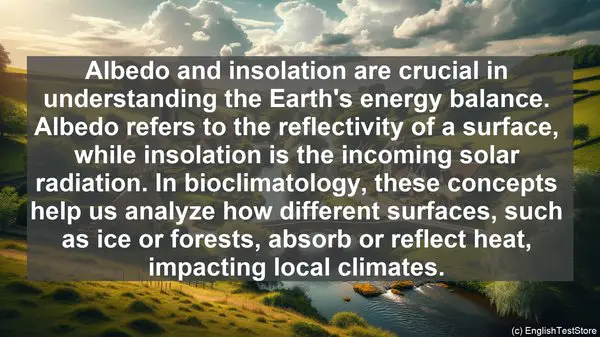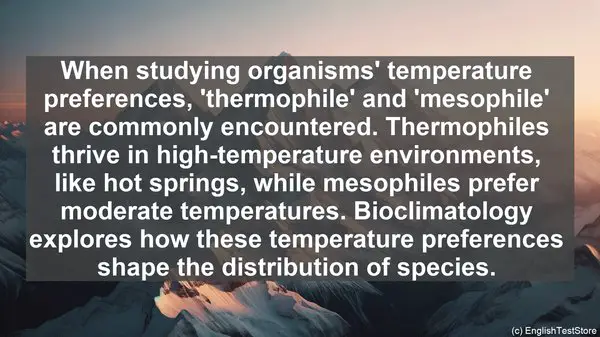Introduction to Bioclimatology
Welcome to this bioclimatology lesson. Before we dive into the subject, it’s essential to understand the precise terminology used. In this lesson, we’ll explore the top 10 commonly confused words in bioclimatology.

1. Weather vs. Climate
The terms ‘weather’ and ‘climate’ are often used interchangeably, but they have distinct meanings. Weather refers to short-term atmospheric conditions, while climate represents long-term patterns. Understanding this difference is crucial in bioclimatology as it helps us analyze the impact of climate change on ecosystems.
2. Adaptation vs. Acclimation
While both ‘adaptation’ and ‘acclimation’ involve an organism’s response to environmental changes, they differ in timescale. Adaptation occurs over generations, involving genetic changes, while acclimation is a short-term adjustment. This distinction is vital when studying how organisms cope with shifts in their bioclimatic zones.
3. Microclimate vs. Macroclimate
Bioclimatology operates at various scales. Microclimate refers to localized, small-scale weather conditions, such as those in a forest. Macroclimate, on the other hand, encompasses larger regions, like a country or continent. Both microclimate and macroclimate influence the distribution and behavior of organisms.
4. Phenology vs. Phenotype
Phenology and phenotype are related but distinct concepts. Phenology focuses on the timing of biological events, such as flowering or migration. Phenotype, on the other hand, refers to an organism’s observable characteristics. In bioclimatology, understanding the phenology of species helps us monitor shifts in their life cycle due to climate change.
5. Ecosystem vs. Biome
While ‘ecosystem’ and ‘biome’ both refer to ecological communities, they differ in scale. An ecosystem is a localized, self-contained unit, like a pond or a forest. A biome, on the other hand, is a broader, global-scale community, such as a desert or tundra. Bioclimatology involves studying the interactions within ecosystems and the distribution of biomes.
6. Endemic vs. Native
When discussing species distribution, ‘endemic’ and ‘native’ are often used. Endemic species are unique to a particular region and found nowhere else, while native species are naturally occurring in an area. Bioclimatology helps us understand the factors that contribute to the endemism of certain species and the impact of introducing non-native species.
7. Albedo vs. Insolation
Albedo and insolation are crucial in understanding the Earth’s energy balance. Albedo refers to the reflectivity of a surface, while insolation is the incoming solar radiation. In bioclimatology, these concepts help us analyze how different surfaces, such as ice or forests, absorb or reflect heat, impacting local climates.

8. Thermophile vs. Mesophile
When studying organisms’ temperature preferences, ‘thermophile’ and ‘mesophile’ are commonly encountered. Thermophiles thrive in high-temperature environments, like hot springs, while mesophiles prefer moderate temperatures. Bioclimatology explores how these temperature preferences shape the distribution of species.
9. Anemometer vs. Wind Vane
Instruments used in meteorology, such as anemometers and wind vanes, have specific functions. An anemometer measures wind speed, while a wind vane indicates wind direction. These tools are essential in bioclimatology for understanding how wind patterns influence the dispersal of seeds or pollen.
10. Isoline vs. Isobar
Isolines and isobars are used in weather and climate maps. An isoline connects points of equal value, such as temperature or precipitation. Isobars, on the other hand, connect points of equal atmospheric pressure. These visual representations aid in understanding spatial patterns and gradients in bioclimatology.
